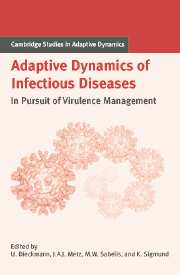Book contents
- Frontmatter
- Contents
- Contributing Authors
- List of Boxes
- Notational Standards
- 1 Introduction
- A Setting the Stage
- B Host Population Structure
- C Within-Host Interactions
- D Pathogen–Host Coevolution
- E Multilevel Selection
- F Vaccines and Drugs
- G Perspectives for Virulence Management
- Introduction to Part G
- 27 Taking Stock: Relating Theory to Experiment
- 28 Virulence Management in Humans
- 29 Virulence Management in Wildlife Populations
- 30 Virulence Management in Veterinary Epidemiology
- 31 Virulence Management in Plant–Pathogen Interactions
- 32 Virulence Management in Biocontrol Agents
- 33 Epilogue
- References
- Index
- International Institute for Applied Systems Analysis
31 - Virulence Management in Plant–Pathogen Interactions
Published online by Cambridge University Press: 15 January 2010
- Frontmatter
- Contents
- Contributing Authors
- List of Boxes
- Notational Standards
- 1 Introduction
- A Setting the Stage
- B Host Population Structure
- C Within-Host Interactions
- D Pathogen–Host Coevolution
- E Multilevel Selection
- F Vaccines and Drugs
- G Perspectives for Virulence Management
- Introduction to Part G
- 27 Taking Stock: Relating Theory to Experiment
- 28 Virulence Management in Humans
- 29 Virulence Management in Wildlife Populations
- 30 Virulence Management in Veterinary Epidemiology
- 31 Virulence Management in Plant–Pathogen Interactions
- 32 Virulence Management in Biocontrol Agents
- 33 Epilogue
- References
- Index
- International Institute for Applied Systems Analysis
Summary
Introduction
Theoretical models have been much improved in their ability to identify factors that are likely to affect the evolution of virulence. However, empirical tests of model predictions are surprisingly few, despite the fact that some factors can be measured and sometimes manipulated under field conditions (e.g., superinfection rates and the relative importance of horizontal versus vertical transmission). Many plant–pathogen interactions appear at first glance to be excellent systems for empirical testing of theoretical models, but a closer examination often reveals features that complicate interpretation. One striking example is the seasonal nature of epidemics of many plant–pathogen interactions (Figure 31.1). Epidemics often display distinct spikes during the plant's growing season followed by a sharp crash in pathogen population size. The crash results from the restricted climatic conditions under which most fungal and bacterial pathogens can infect plants (Agrios 1988). As a consequence, epidemics are not simply limited in occurrence by the availability and density of susceptible hosts, but also by climatic conditions conducive to infection. Indeed, some disease-management strategies are designed to take advantage of these climatic constraints by requiring that crops be planted either in areas not conducive to disease development (spatial escape from disease) or during seasons when epidemics are unlikely (temporal escape). This seasonal fluctuation suggests that plant and pathogen are rarely, if ever, at numerical equilibrium. It is also unlikely that virulence is under intense selection during the decline or crash phase of an epidemic (Figure 31.1).
- Type
- Chapter
- Information
- Adaptive Dynamics of Infectious DiseasesIn Pursuit of Virulence Management, pp. 436 - 447Publisher: Cambridge University PressPrint publication year: 2002

